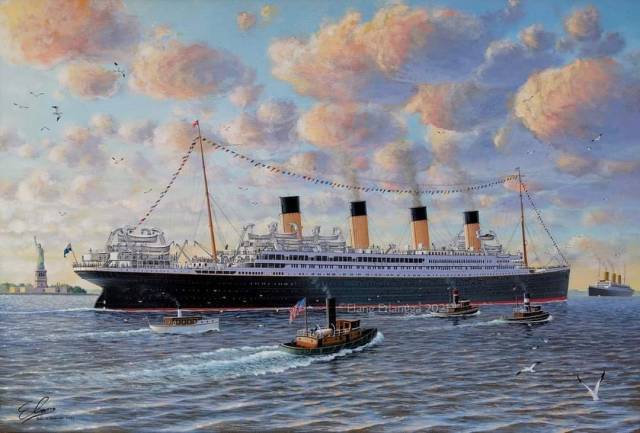Britannic:
The Palace That Never Was
While Olympic and Titanic are justifiably famous for their luxuries, many people forget about the planned luxury of the third vessel in the trio, the ill-fated Britannic.
RMS Britannic, had the fortunes of war not intervened, would have surpassed her earlier sisters in luxurious accommodations and appointments. The progression from the original design realized in Olympic and the final form intended for Britannic also shows the White Star Line’s continual quest to provide their passengers with the pinnacle of oceangoing luxury travel.
All classes would’ve garnered improvements in the third iteration of the class. While Britannic’s large gantry davits would mark an obvious difference with the earlier ships on the outside, smaller changes would have been clear to the practiced eye. They roofed the aft well deck to provide passengers in Steerage with a covered promenade, giving all three classes such a feature. An added deckhouse on the poop also would’ve provided those travelling in third-class a more commodious smoking room above decks.
First-class passengers who had journeyed on one of the earlier ships would’ve noticed a new dome over the smoking room, an additional elevator, and a children’s playroom among other additions. The real change, however, would’ve been the exquisitely crafted pipe organ rising from A-deck’s landing of the forward grand staircase. This Welte philharmonic organ, along with many other pieces that never made it aboard the liner, survives today. The organ is located in Seewen, Switzerland at the Museum Für Musikautomaten.
Passengers travelling in the ship’s first class would also have been treated to something that was to become expected by the time Olympic left service in the mid-1930s. Virtually every first-class stateroom would’ve come equipped with a private bathroom. A rare feature on the first two sisters, Britannic would’ve been cutting edge in this regard and, had she survived, would’ve been far more in line with 1930s passenger expectations, raising the possibility that she might have survived longer than her eldest sister.
It was, unfortunately, not to be. Britannic was never fully fitted out as a passenger liner, requisitioned for service as a hospital ship. It was in this much plainer guise that she was lost on 21 November 1916 in the Aegean Sea. We are left to examine blueprints and advertising mock-ups, as well as our own imaginations, to know what might have been for this beautiful ship.


